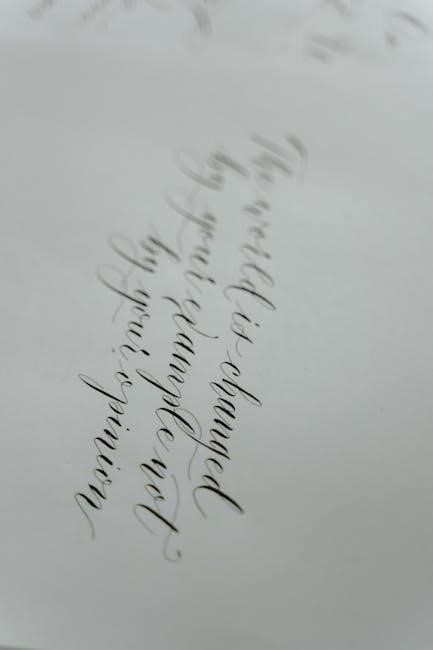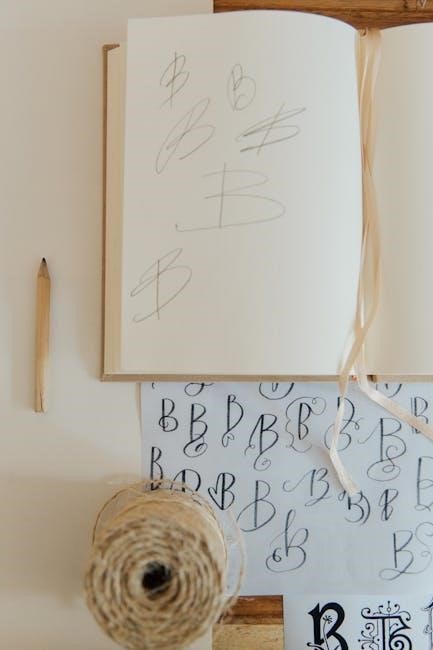Handwriting Practice PDF: A Comprehensive Guide
Embark on a journey to refine your penmanship with our comprehensive guide to handwriting practice PDFs. Discover resources, tips, and customizable worksheets to improve your skills, whether you’re a student, professional, or simply seeking self-improvement in writing.
Handwriting practice is the deliberate and consistent act of refining one’s penmanship, aiming for improved legibility, speed, and aesthetic appeal. It involves repetitive exercises focused on letter formation, spacing, and overall consistency. Regular practice strengthens the neural pathways responsible for motor skills, leading to more fluid and natural writing. Whether you’re mastering cursive, print, or D’Nealian styles, focused repetition using handwriting practice sheets is key. Start by identifying areas for improvement, like letter slant or size consistency. Then, select appropriate worksheets and dedicate time to consistent practice, observing how each stroke contributes to the overall flow and readability of your handwriting.

Benefits of Handwriting Practice
Handwriting practice enhances cognitive skills, boosts personal expression, and offers educational advantages. It improves memory, fine motor skills, and focus, fostering creativity and academic success through enhanced writing proficiency and overall penmanship development.
Cognitive Development
Engaging in handwriting practice significantly contributes to cognitive development. The act of forming letters enhances fine motor skills and hand-eye coordination. This process stimulates brain activity, improving memory and recall. Consistent practice strengthens neural pathways, leading to enhanced cognitive function. Handwriting also encourages focus and attention, crucial for learning and problem-solving.
Furthermore, it fosters critical thinking and creativity as individuals translate thoughts into written form. Regular handwriting exercises can improve information retention, making it an invaluable tool for students and professionals alike. Ultimately, handwriting practice serves as a powerful catalyst for cognitive growth and intellectual development.
Personal Growth
Handwriting practice extends beyond skill development, fostering personal growth and self-expression. Improving one’s handwriting can boost confidence and self-esteem, as individuals take pride in their work. The act of writing allows for introspection and reflection, promoting mindfulness and self-awareness. Consistent practice cultivates patience and perseverance, valuable traits applicable to various aspects of life.
Moreover, legible handwriting enhances communication, fostering stronger connections with others. It provides a unique avenue for creativity, allowing individuals to develop a personal writing style. Embracing handwriting practice promotes self-discipline and a sense of accomplishment, contributing to a more fulfilling and empowered personal journey.
Educational Advantages
Handwriting practice offers significant educational advantages for students of all ages. Improved handwriting skills enhance note-taking efficiency, enabling students to capture information accurately and effectively during lectures. Clear and legible handwriting makes it easier for teachers to grade assignments, leading to fairer evaluations. Strong handwriting skills contribute to improved spelling and grammar, as students develop a better understanding of letter formation and word structure.
Furthermore, handwriting promotes cognitive development, enhancing memory and critical thinking skills. It fosters a deeper connection with the material being learned, leading to improved comprehension. Ultimately, proficient handwriting empowers students to express their ideas confidently and succeed academically.

Types of Handwriting Practice Worksheets
Explore diverse handwriting practice worksheet types, including print, cursive, and style-specific options like D’Nealian and Zaner-Bloser. Each offers unique benefits for developing specific handwriting skills and catering to individual learning preferences.
Print Handwriting Worksheets
Print handwriting worksheets are fundamental tools designed to develop legible and consistent letter formation. These worksheets typically feature dotted lines for tracing, gradually transitioning to independent practice. They often include uppercase and lowercase letters, numbers, and simple words. These resources are especially beneficial for young learners in preschool and kindergarten, establishing a strong foundation for writing skills.
Print handwriting worksheets also serve as a valuable resource for individuals seeking to improve their overall penmanship. They are available in various formats, some incorporating themed designs and positive affirmations to engage learners and enhance motivation. Consistent practice with these worksheets promotes fine motor skills and builds confidence in writing.
Cursive Handwriting Worksheets
Cursive handwriting worksheets offer a structured approach to mastering the flowing strokes and connected letterforms of cursive script. These worksheets often begin with individual letter practice, guiding the learner through each curve and loop. Progressing to words and sentences, they reinforce letter connections and improve fluency.
Cursive worksheets are designed for various skill levels, from beginners learning basic strokes to those seeking to refine their style. Many resources provide practice with common words and phrases, while others incorporate historical documents or famous quotes for added interest. Regular practice with cursive worksheets enhances motor skills, cognitive development, and appreciation for this elegant writing style.
DNealian and Zaner-Bloser Styles
DNealian and Zaner-Bloser are two prominent handwriting styles taught in schools, each with distinct characteristics. DNealian, known for its slanted, continuous strokes and simplified letterforms, aims to ease the transition from print to cursive. Its unique letter shapes, like the lowercase ‘a’ and ‘g’, are designed to promote fluid writing.
Zaner-Bloser, a more traditional style, emphasizes vertical strokes and distinct letter formations. It focuses on precision and legibility, with letters often appearing more formal than DNealian. Handwriting practice PDFs are available for both styles, offering structured exercises to master each alphabet and improve overall penmanship using specific techniques tailored to each.

Creating Custom Handwriting Worksheets
Design personalized handwriting worksheets to suit specific needs. Explore online tools, adjust font styles and sizes, and incorporate themed designs. Tailor your handwriting practice for optimal learning and engagement.
Using Online Worksheet Wizards
Harness the power of online worksheet wizards to effortlessly generate tailored handwriting practice materials. These tools offer a user-friendly interface, allowing you to create custom worksheets in minutes. Choose from various handwriting styles like D’Nealian or Zaner-Bloser, and select either print or cursive formats to match your specific learning objectives.
These wizards often provide options to adjust font sizes, line spacing, and the content of the practice sheets. You can create alphabet worksheets, spelling practice sheets, or even incorporate personalized sentences. Many wizards are free, making them accessible for parents, teachers, and individuals seeking to enhance their handwriting skills efficiently.
Adjusting Font Styles and Sizes
Fine-tuning the font style and size is crucial for effective handwriting practice. Experiment with different font types, such as dotted letters for tracing, or solid lines for independent practice. Select font styles that mimic the desired handwriting form, be it print, cursive, or specific styles like D’Nealian.
Adjusting the font size is equally important. Larger fonts are ideal for beginners, providing ample space to practice letter formation. As skills improve, gradually reduce the font size to encourage more refined and controlled handwriting. This customization allows for a progressive learning experience tailored to individual needs and abilities.
Incorporating Themed Designs
Adding themed designs to handwriting practice worksheets can significantly boost engagement and motivation, particularly for younger learners. Integrate elements related to seasons, holidays, animals, or popular characters to create a fun and stimulating learning environment.
Visually appealing designs can make the practice more enjoyable, reducing resistance and fostering a positive association with handwriting; Consider using themed borders, illustrations, or even incorporating thematic vocabulary into the practice sentences or words. Themed designs can transform mundane practice into an exciting activity, encouraging consistent effort and improving handwriting skills effectively.

Free Printable Handwriting Resources
Access a wealth of free, printable handwriting resources to enhance your practice. These resources encompass alphabet tracing, word exercises, and number drills, catering to diverse learning needs and skill levels.
Alphabet Tracing Worksheets
Embark on your handwriting journey with alphabet tracing worksheets, a cornerstone for developing letter formation skills. These resources offer guided practice for both uppercase and lowercase letters, crucial for beginners. Tracing helps to instill muscle memory and improve hand-eye coordination, laying a solid foundation for legible handwriting.
From simple block letters to more stylized fonts, these worksheets cater to various preferences and learning styles. Explore dotted lines and gray outlines to guide each stroke. Consistent practice with alphabet tracing will ensure proper letter construction, spacing, and overall neatness.
Word and Sentence Practice Sheets
Elevate your handwriting skills with dedicated word and sentence practice sheets. These worksheets transition beyond individual letters, focusing on combining letters to form coherent words and sentences. Practice sheets often incorporate sight words, common vocabulary, and positive affirmations to make learning engaging and beneficial.
These resources enhance your ability to maintain consistent letter size, spacing, and baseline alignment within connected text. They offer opportunities to develop fluidity and rhythm in your handwriting, improving speed and legibility. Regular practice will ensure your handwriting becomes more automatic and refined, suitable for everyday writing tasks.
Number Tracing Worksheets
Enhance your numeral writing skills with number tracing worksheets, designed for learners of all ages. These worksheets provide a structured way to practice forming numbers correctly, improving legibility and consistency. From basic digits 0-9 to larger numbers, these resources cater to different skill levels.
Number tracing is particularly beneficial for preschool and kindergarten children learning to write numbers for the first time. The dotted lines guide their hand movements, helping them develop muscle memory and proper number formation habits. These sheets also aid in improving pencil control and hand-eye coordination, essential for early writing development, and even into adulthood.
Handwriting Practice for Different Age Groups
Tailored handwriting practice is essential for all ages. We explore methods for preschoolers, elementary students, and adults, addressing unique needs and goals for handwriting improvement at every stage of life.
Preschool and Kindergarten
Introducing handwriting to preschoolers and kindergarteners requires a playful and engaging approach. Focus on basic strokes, letter recognition, and proper pencil grip. Use large, traceable letters and themed worksheets to capture their attention. Activities should be short and fun, incorporating colors and pictures to stimulate their interest.
Dotted letters are especially effective at this age, allowing children to trace and build muscle memory. Writing formation guides can be helpful, but experiment to find what works best for each child. The goal is to create a positive first experience with writing and develop a foundation for future handwriting skills.
Elementary School Students
For elementary school students, handwriting practice shifts towards refining letter formation, size consistency, and spacing. Worksheets should include opportunities to practice both print and cursive styles, with a focus on developing fluency. Incorporate sentence writing to improve overall penmanship and encourage the use of proper grammar and punctuation.
Use themed worksheets to make practice more engaging and relevant to their interests. Positive affirmations about becoming a better writer can boost confidence. Regular practice with well-designed handwriting sheets helps students develop legible and efficient handwriting skills that will benefit them throughout their academic journey.
Adult Handwriting Improvement
Adults seeking to improve their handwriting can benefit from targeted practice focusing on consistency and legibility. Identify specific areas for improvement, such as letter formation or spacing, and utilize worksheets that address these issues. Consider exploring different handwriting styles, like cursive or print, to find one that suits your personal preference and needs.
Regular practice, even for short periods, can lead to significant improvements over time. Utilize online resources and custom worksheet generators to create personalized practice materials. Focus on mindful writing, paying attention to each stroke and the overall appearance of the writing. This will help you develop a more consistent and legible handwriting style.

